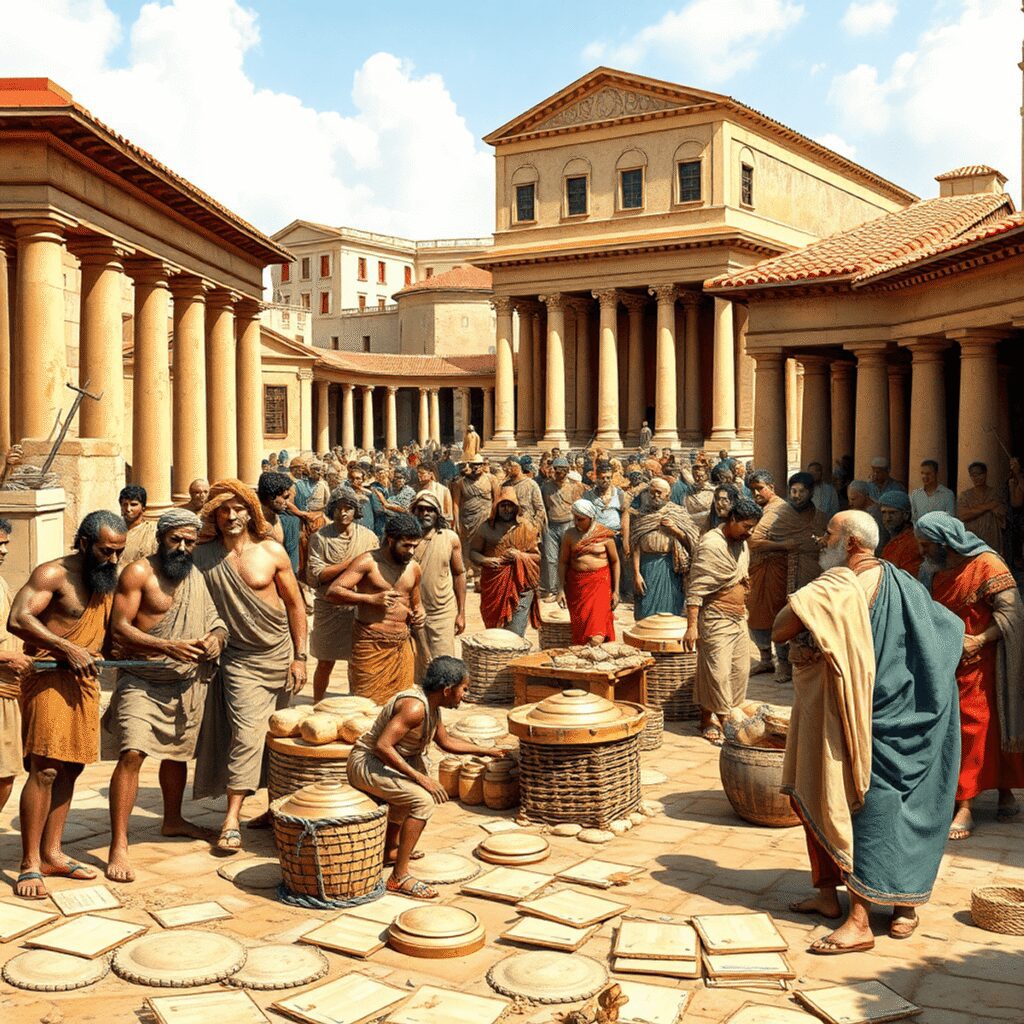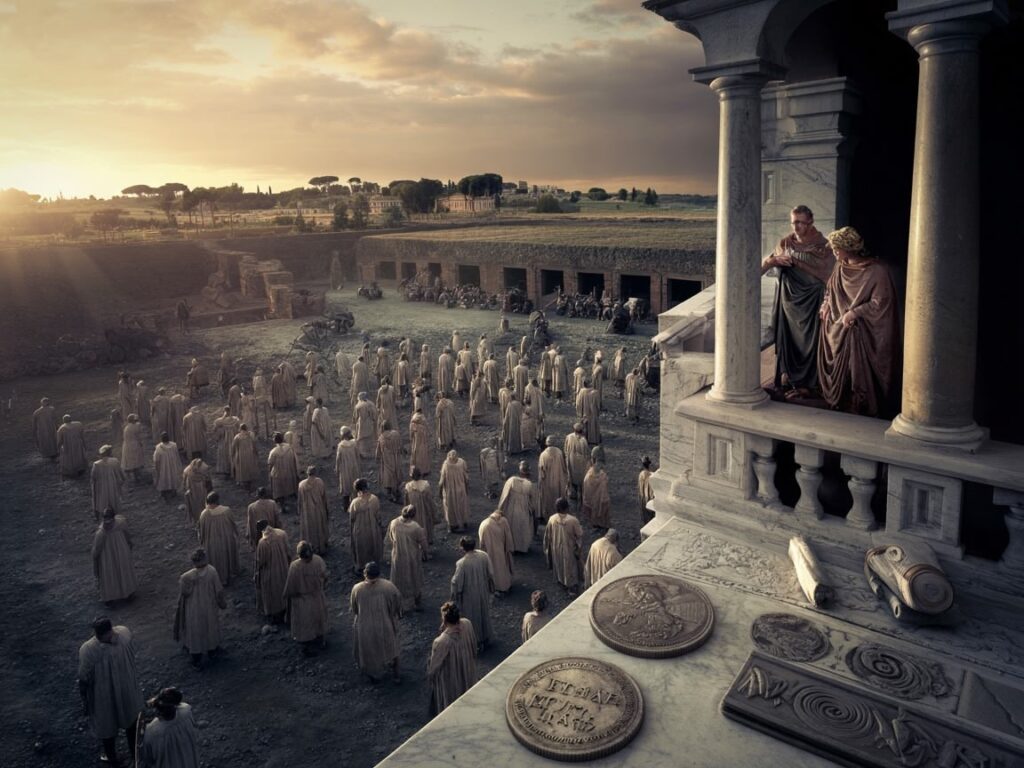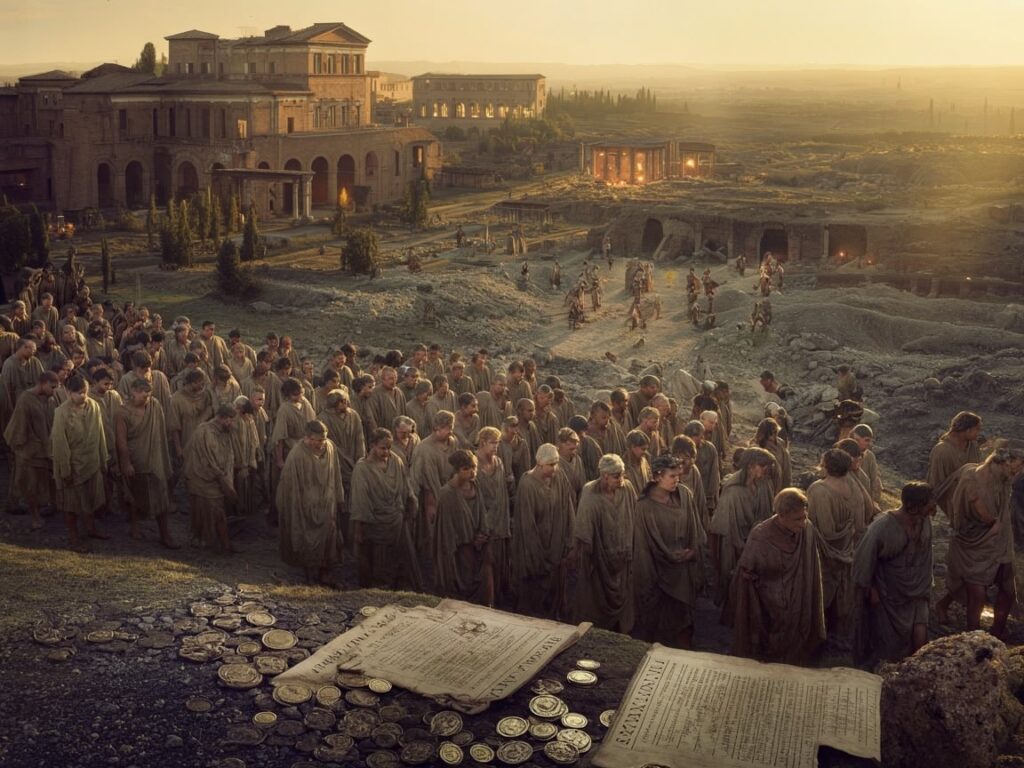Slavery was a cornerstone of the economics of slavery in Ancient Rome: impact on innovation and society. It permeated every layer of Roman life, fueling agricultural production, mining operations, and domestic services. Slaves were not only laborers but also skilled professionals, shaping economic activities across the empire.
Studying the economic and social implications of Roman slavery reveals how deeply intertwined this system was with Rome’s growth and its societal hierarchies. It provides insight into why certain technological innovations lagged despite Rome’s vast resources and intellectual capabilities.
This article explores a central thesis: slavery in Ancient Rome acted both as an economic enabler and a barrier to innovation. While it supported large-scale production through cheap forced labor, it simultaneously limited incentives for technological progress and altered social structures by creating distinct classes with complex interactions. Understanding this dual role sheds light on the broader dynamics that shaped Roman society and economy.
The influence of Roman society on Western civilization is profound, with intricate social structures, cultural practices, and innovative ideas laying the groundwork for many aspects of modern life. From their legal systems, which have an enduring legacy, to their artistic masterpieces that reflect aesthetic values as well as the social, political, and cultural dynamics of their time, the legacy of Rome is woven into the very fabric of contemporary society.
Moreover, Roman religious practices were deeply connected to the divine through rituals and sacrifices. This belief system emphasized maintaining good relationships with their deities, further influencing various aspects of their daily life.

The Foundation of Slavery in Ancient Rome
The origins of slavery in Ancient Rome were closely connected to the Republic and Empire’s expansionist nature. The main sources of slaves were:
- Conquest and war captives: Defeated peoples were routinely enslaved, fueling a steady supply during military campaigns.
- Piracy: Kidnapping for ransom or sale contributed to the slave population.
- Debt slavery: Citizens unable to repay debts could fall into servitude, though this form declined over time.
Legal Status of Slaves
In Roman law, slaves had a unique legal status. They were considered res—property rather than individuals—without any legal rights or personhood. This classification gave owners almost complete control over their slaves, allowing them to buy, sell, or punish without facing any legal consequences.
The Peculium System
Despite this harsh reality, there was an unusual system called peculium that allowed slaves to manage a small amount of personal wealth or property with their master’s permission. This arrangement enabled some slaves to run businesses, save money, and even buy their freedom.
Diverse Roles of Slaves
The tasks assigned to slaves were varied and showed great diversity. In addition to demanding unskilled work in farming and mining, many slaves held skilled jobs:
- Artisans creating products
- Educators teaching children of the wealthy
- Accountants handling financial records
- Physicians caring for families
This specialization demonstrated the intricate economy and society where slavery existed at different levels of production and social interaction. It laid the groundwork for understanding how slavery shaped economic practices and societal dynamics in Ancient Rome.

Economic Role of Slavery in Roman Society
The Roman economy was deeply intertwined with a slave labor economy that permeated multiple sectors:
1. Agriculture
The backbone of Rome’s wealth relied heavily on slave labor to cultivate vast estates (latifundia). Slaves performed grueling physical work such as planting, harvesting, and tending livestock, enabling large-scale production at minimal cost.
2. Mining and manufacturing
Slaves toiled in dangerous mines extracting precious metals and worked in workshops producing goods ranging from pottery to textiles. These industries benefited from the steady supply of inexpensive forced labor.
3. Urban skilled professions
Not all slaves performed manual tasks. Many were trained as artisans, craftsmen, teachers, physicians, or accountants. This skilled labor contributed significantly to the operation of households, businesses, and even public administration.
The cost-benefit analysis of slaves versus free laborers favored slavery for Roman elites. Maintaining a slave involved providing food, shelter, and basic care—expenses generally lower than wages paid to free workers who required salaries sufficient to support families and personal freedoms. Slaves could be made to work longer hours without legal entitlement to rest or overtime pay.
A spectrum of tasks illustrates the economic versatility of slaves:
- Unskilled labor: fieldwork, mining, domestic chores
- Skilled occupations: pottery makers, scribes, teachers
- Administrative roles: managing estates or businesses under their masters’ supervision
This multi-faceted use of slave labor formed the economic foundation sustaining Roman production and wealth accumulation.
However, the economic structure was not solely dependent on slavery. The Roman military also played a crucial role in maintaining this system. The military machine was not merely a collection of soldiers; it was a well-oiled apparatus that combined discipline, strategy, and innovation. At its peak, the Roman army was a reflection of the empire itself—vast, diverse, and intricately structured.
Moreover, the societal values and beliefs reflected in the Roman Pantheon also influenced the economic landscape. The diverse collection of gods and goddesses worshipped in ancient Rome mirrored the customs that shaped the lives of its people.

Social Implications of Slavery in Ancient Rome
Manumission—the formal process of freeing slaves—was a widespread institution that deeply influenced social mobility within Roman society. Unlike many other ancient systems, Roman manumission granted former slaves, known as freedpersons, partial citizenship and legal recognition. This transformation allowed freedpersons to engage in business, own property, and sometimes even participate in political life, although certain restrictions remained.
The emergence of freedpersons created a distinct social stratum within the complex hierarchy of Rome. They occupied an intermediate position between slaves and freeborn citizens, often serving as merchants, artisans, or administrators. Freedpersons could accumulate wealth and influence over generations, gradually assimilating into higher social classes through marriage or economic success.
Key aspects include:
- Manumission as a tool for upward mobility
It provided slaves with hope and incentive to develop skills valued by their owners, indirectly supporting economic activity. - Legal rights for freedpersons
Though not equal to freeborn citizens, they gained protections under Roman law and could pass on limited inheritance rights. - Social tensions
The growing class of freedpersons sometimes faced suspicion or discrimination from traditional elites who viewed them as socially inferior despite their legal status.
The dynamics surrounding manumission and freedpersons reveal how slavery shaped social structures beyond mere economic exploitation. This complex interplay set the stage for broader societal changes and influenced the cultural fabric of Ancient Rome.
Interestingly, this cultural fabric was also reflected in the art of the time. For instance, Roman sculpture, which evolved significantly over time, showcased a distinct focus on realism and the portrayal of power. These sculptures served not only as artistic expressions but also as instruments for political propaganda and religious devotion.
Slavery’s Impact on Innovation and Technological Progress in Ancient Rome
The Roman economy’s heavy dependence on abundant cheap forced labor created significant disincentives for innovation. When slaves provided a readily available workforce requiring minimal financial outlay beyond sustenance, there was little economic pressure to pursue or invest in new technologies. Owners could maximize output simply by increasing the number of slaves rather than improving efficiency through innovation.
This dynamic contributed to a notable technological stagnation in key sectors. Unlike societies where labor costs incentivized the development of machinery or automation, Rome saw limited progress in labor-saving technology. For instance:
- Agricultural tools remained relatively primitive compared to later innovations.
- Industrial processes in mining and manufacturing showed minimal mechanization.
- Watermills and other devices existed but did not become widespread replacements for manual labor.
The absence of labor-saving technology reflected not only economic calculations but also social attitudes that valued control over efficiency. Investment in machinery risked undermining the established system dependent on human labor as property. The result was an economy that expanded largely through increased inputs like land and slaves rather than improvements in productivity or technological advancement.

Cultural and Institutional Barriers to Innovation in Ancient Rome
Roman Elite Attitudes Toward Innovation
The attitudes of the Roman elite had a significant impact on innovation during that time. The ruling class often viewed technological change with suspicion. Innovations had the potential to disrupt the established social order or undermine the control elites held over their vast slave populations. For example, labor-saving machines or processes risked reducing the demand for slaves, threatening the economic foundation of elite wealth and status.
Limited Legal Framework on Innovation
The legal framework on innovation was limited and did not support inventors or entrepreneurs effectively. Intellectual property rights, as understood today, were weak or virtually nonexistent. Without formal protections, inventors lacked incentives to invest time and resources into developing new technologies because others could easily appropriate their ideas without compensation.
Key Barriers to Innovation in Ancient Rome
Several key barriers hindered innovation in Ancient Rome:
- Fear of social disruption: Innovations that could empower slaves or free labor threatened elite dominance.
- Absence of patent-like protections: No guaranteed exclusive rights to inventions made innovation financially risky.
- Legal treatment of slaves: As property without personhood, slaves’ creative contributions were ignored or undervalued within legal and economic systems.
This environment stifled technological experimentation and adoption. The combination of elite conservatism and institutional shortcomings created a cultural atmosphere resistant to change, reinforcing Rome’s dependence on traditional methods supported by abundant slave labor. Moreover, these issues were compounded by political instability and weak leadership, further undermining the potential for innovation in this ancient civilization.
Understanding Economic Growth in Ancient Rome
Economic growth in Ancient Rome was shaped significantly by inputs rather than improvements in productivity. The expansion of capital stock—primarily through land acquisition and increases in the slave population—served as the main engine for economic development.
Factors Driving Economic Growth
These factors fueled output increases but did not correspond with notable gains in total factor productivity (TFP). Unlike economies driven by innovation or efficiency improvements, Rome’s economy exhibited limited technological progress or enhanced resource utilization per unit input.
- Land acquisition: Conquests brought vast territories under Roman control, providing new agricultural lands to exploit using slave labor.
- Slave population growth: War captives and other sources replenished the labor force cheaply and abundantly, enabling larger-scale production without raising labor costs.

The Role of Slavery in Economic Development
The reliance on expanding inputs aligns closely with the broader themes seen in The Economics of Slavery in Ancient Rome: Impact on Innovation and Society. Cheap, plentiful forced labor reduced incentives to pursue innovations that would improve efficiency. Instead of investing in new tools or processes, Roman landowners and entrepreneurs found it more profitable to increase their scale by acquiring more slaves and land.
Contrasting Models of Growth
This model of growth contrasts with later economies where technological advances play a central role. In Rome, economic success depended heavily on maintaining and growing its resource base rather than transforming how those resources were used.
The trade and economy in Ancient Rome, which were foundational to its vast empire, reveal the significance of economic practices that shaped one of history’s most powerful civilizations. You can explore this topic further in our comprehensive guide on trade and economy in Ancient Rome.
Conclusion
The economics of slavery in Ancient Rome reveals a complex dynamic with a dual role:
- An enabler for economic scale, providing vast labor resources that fueled agricultural and infrastructural expansion.
- An inhibitor for technological progress, as the abundance of cheap slave labor reduced incentives to develop or adopt labor-saving innovations.
This duality left a profound legacy of Roman slavery shaping the economic consequences and societal development trajectory of the empire. The reliance on forced labor created sustained growth through expanding inputs like land and slaves, but at the cost of stagnation in productivity and industrial advancement.
Understanding this interplay offers valuable lessons about how economic systems deeply entwined with coerced labor can hinder innovation despite short-term gains. The lasting effects of slavery’s economic model illuminate broader themes in historical economies where social structures influence technological change and societal evolution.
Studying The Economics of Slavery in Ancient Rome: Impact on Innovation and Society exposes these tensions, enriching our grasp of Rome’s history and the complexities behind economic development. Additionally, exploring how emperors utilized coins as propaganda, provides further insight into the intersection of economics and power during this period. These small pieces of currency were not merely a means of trade; they became significant instruments for political messaging, reflecting the authority and legitimacy of the rulers.
FAQs (Frequently Asked Questions)
What was the economic role of slavery in Ancient Rome?
Slavery formed the backbone of Ancient Rome’s economy, providing cheap labor across agriculture, mining, and manufacturing sectors. Slaves performed a wide range of tasks from unskilled labor to skilled professions such as artisans and educators, making the economy heavily dependent on this forced labor system.
How did slavery impact innovation and technological progress in Ancient Rome?
The reliance on abundant cheap slave labor created disincentives for innovation, leading to technological stagnation. There was limited development or adoption of labor-saving technologies because the economic incentive to innovate was reduced by the availability of forced labor.
What were the social implications of slavery in Roman society?
Slavery affected social structures through practices like manumission, which allowed some slaves to gain freedom and become freedpersons—a distinct social class with legal rights. This dynamic influenced social mobility and contributed to complex class stratifications within Roman society.
How did cultural and institutional factors hinder innovation in Ancient Rome?
Roman elites often feared that innovations could disrupt the social order or reduce their control over slaves. Additionally, weak or nonexistent intellectual property protections discouraged investment in new technologies, creating cultural and legal barriers to innovation.
What drove economic growth dynamics in Ancient Rome despite limited technological progress?
Economic expansion in Ancient Rome was primarily driven by increased inputs such as land acquisition and growth in the slave population rather than improvements in total factor productivity or efficiency gains. This input-driven growth sustained the economy despite technological stagnation.
What is the lasting legacy of Roman slavery on economic and societal development?
Roman slavery played a dual role by enabling large-scale economic activity while simultaneously inhibiting technological progress. Its legacy shaped Roman history profoundly, offering important lessons for understanding how forced labor systems can influence economic consequences and societal trajectories over time.

